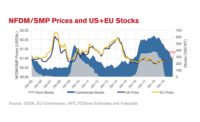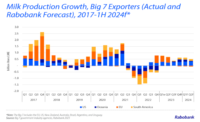The Price of Being Local
James Dudlicek
Editor
(847) 405-4009
I’m not the only one in this industry with a fondness for the Food Network, and of its many personalities, Alton Brown — with his blend of food science and fun — is one of my favorites.
I had the opportunity to see Brown among the speakers
at the recent IDDBA conference, and enjoyed his dissection of today’s
food trends and fads. Of particular interest was his take on the resonance
of certain buzzwords with consumers at large. Amid the chorus of
“organic” and “natural” (the true definitions of
which many would be hard-pressed to provide), the concept Brown contends
people really understand is “local” — food that’s
produced not so very far away from where they live.
That got me to thinking about whether dairy —
with its consolidation mania of the past decade or so — will find
itself on the wrong side of that trend. It struck me as particularly
significant because of the recent spate of acquisitions — illustrated
in the Top 100 processors ranking this month — coming around the time
this trend is picking up steam.
Several more independent, regional processors —
Friendship Dairies, Crystal Cream & Butter and LuVel Dairy, for example
— were scooped up by major players — Dean, Hood and Prairie
Farms, in these cases. Whether or not this heralds the next consolidation
tidal wave, we have yet to see.
Now, in cases where local management has a degree of
autonomy, it may not matter. Dean units like Mayfield and Purity continue
to operate, for the most part, like they did when independent, at least as
far as consumers are concerned; these processors retain a deep identity
with their Tennessee roots despite ownership in Dallas.
But if consolidation means plant closings and products
being shipped across longer and longer distances (a practice that fuel
prices have made undesirable), dairy will give up any claim to the
“local” trend.
Shortly before press time, our top-ranked processor
took a hit on Wall Street after trimming its earnings outlook, a move
blamed on milk prices reaching new record levels.
The problem is further exacerbated, according to folks
at Dean, by an oversupply of organic milk, due to a change in organic
regulations that led many farmers to enter a one-year transition process
before the new rule took effect. Some financial analysts doubt that
Dean’s scale will completely protect the company from volatile
commodities pricing.
As our category review of organic dairy products this
month contends, the abundance of organic milk has led to increased product
development in this segment, and perhaps will expose a greater number of
consumers to trial.
Meanwhile, the elasticity of dairy in general will be
stretched to the limit, as the gallon price for milk at retail approaches
that of gasoline. Will credit-card companies start putting caps on grocery
charges, too?
$OMN_arttitle="The Price of Being Local";?>
$OMN_artauthor="James Dudlicek";?>
